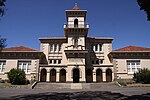Electoral district of Geelong (Victorian Legislative Council)
The Electoral district of Geelong was one of the original sixteen electoral districts of the old unicameral Victorian Legislative Council of 1851 to 1856. Victoria being a colony in Australia at the time. The Electoral district of Geelong's area was defined as: "Bounded by a line drawn from a point on the eastern shores of Corio Bay near Point Henry at a distance of 2 miles from the north-east corner of the Township of Geelong as a centre bearing southerly to a point bearing east from the said corner thence by a line south crossing a small portion of Corio Bay parallel with and at a distance of 2 miles from the eastern boundary of the said township to a point bearing east from the south-east corner of the said Township of Geelong thence by a line drawn westerly at a distance of 2 miles from the southern boundary of the said township crossing the Barwon River and Waurn Chain of Ponds to a point 2 miles west of the south-west corner of the said township thence by a line bearing north parallel with and at a distance of 2 miles from the western boundary of the said Township of Geelong to a point bearing west from the north-west corner of the said township thence by a line drawn at a distance of 2 miles from the north-west corner of the said township as a centre to the western shore of Corio Bay near Cowie's Creek and also to include the remaining portion of the reserve at Point Henry and the reserve at the junction of the Moorabool with the Barwon River."From 1856 onwards, the Victorian parliament consisted of two houses, the Victorian Legislative Council (upper house, consisting of Provinces) and the Victorian Legislative Assembly (lower house).
Excerpt from the Wikipedia article Electoral district of Geelong (Victorian Legislative Council) (License: CC BY-SA 3.0, Authors).Electoral district of Geelong (Victorian Legislative Council)
Virginia Street, Geelong Newtown
Geographical coordinates (GPS) Address Nearby Places Show on map
Geographical coordinates (GPS)
| Latitude | Longitude |
|---|---|
| N -38.15 ° | E 144.35 ° |
Address
Virginia Street 27
3220 Geelong, Newtown
Victoria, Australia
Open on Google Maps









